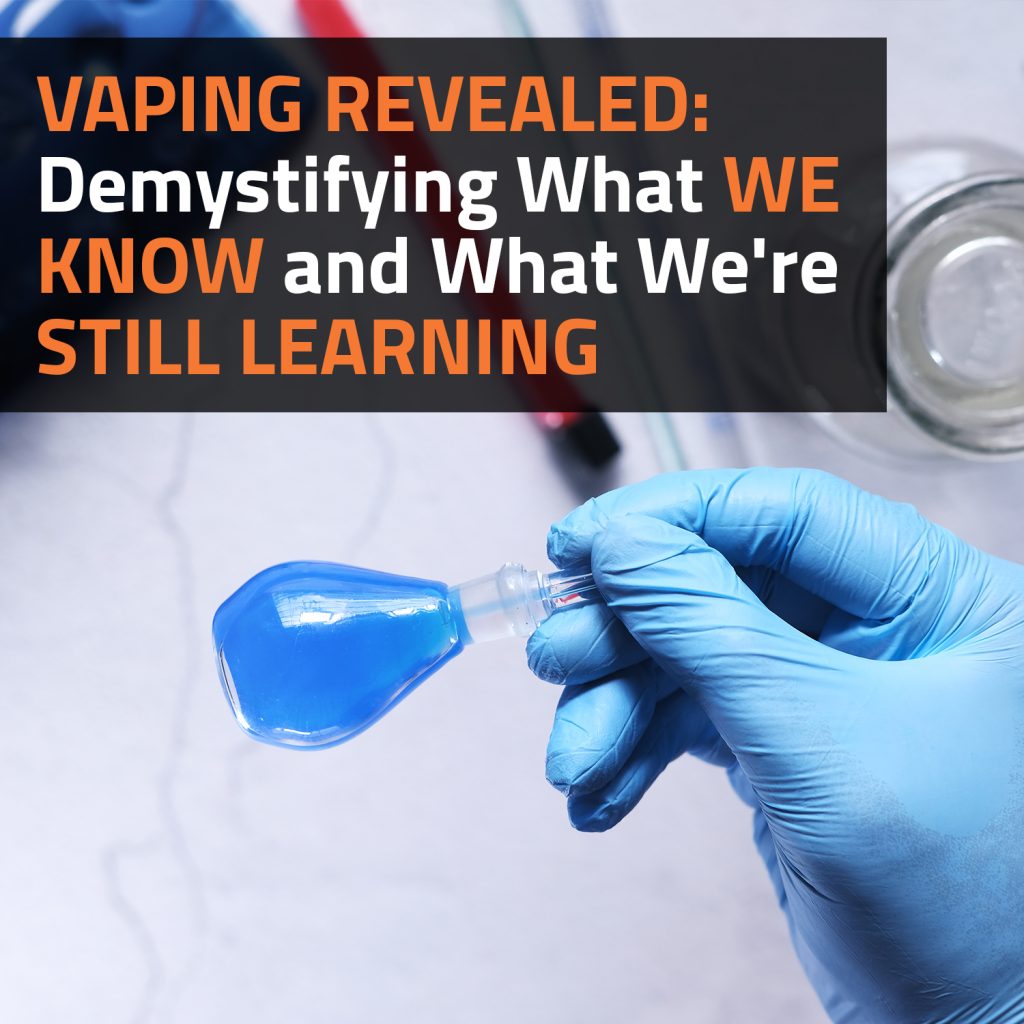Vaping, once hailed as the cutting-edge alternative to traditional smoking, has paved its own unique path in the annals of public health and cultural significance. It’s a world where sleek gadgets meet swirling clouds of vapour and flavourful e-liquids, and where questions about health intertwine with considerations of personal freedom.
This article delves into the multifaceted realm of vaping – from its historical roots to its present-day implications, exploring both its celebrated advantages and the concerns shadowing its rise. As we navigate the intricacies of vaping’s impact on society, we’ll uncover the known facts and shed light on areas still shrouded in mystery.
History Of Vaping And Its Cultural Significance
Vaping, while now a modern phenomenon, traces its origins to ancient times. Ancient Egyptians employed a method of vaporising herbs using hot stones. The concept of an electronic cigarette was first proposed in 1963, but it took until 2003 for the first modern e-cigarette to be introduced to the market, courtesy of a pharmacist from China.
In the contemporary era, vaping gained traction primarily as a smoking alternative. Its rapid ascent in popularity is attributable to its purported health advantages over traditional smoking, variety in vaping liquids, and a sense of community among vapers. Moreover, it has cemented its place in today’s culture, with vape cafes and conventions becoming staples in urban locales.
What Is Vaping?
Vaping refers to the act of inhaling and exhaling vapour produced by an electronic cigarette or similar device. Unlike traditional cigarettes, these devices do not burn tobacco; instead, they heat a liquid solution, commonly known as e-liquid or vape juice. This e-liquid contains varying concentrations of nicotine, flavourings, and other chemicals. The process produces vapour, which mimics the sensation of smoking without the combustion of tobacco.
Components Of A Vape
A standard vaping device is a harmony of engineering and design, constructed to optimise the user experience while ensuring safety. Typical vaping devices are made up of the following parts:
- Atomiser
- Battery
- E-liquid
- Mouthpiece
-
Geekvape Wenax Q Pro
R550.00
Atomiser
At the heart of every vape is the atomiser. It houses the coil that heats the vaping liquid, converting it into vapour. Its design and quality play a crucial role in the efficiency of vapour production.
Battery
Powering the atomiser is the battery. Typically rechargeable, the battery’s capacity and output determine the device’s longevity and performance. Higher capacity batteries allow for prolonged usage, while variable outputs let users customise their vaping experience.
Liquid Solution (E-Liquid)
Vaping liquids, or e-liquids, are mixtures containing a base, which is usually propylene glycol or vegetable glycerin, flavourings, and often nicotine. They come in a multitude of flavours, from traditional tobacco to fruity concoctions, catering to a vast array of palates.
-
VGOD – Mango Bomb Regular
R320.00 -
VGOD MTL – Lushice
R350.00 -
VGOD MTL – Purple Bomb Iced
R350.00 -
VGOD Saltnic – Banana Bomb Iced
R350.00
Mouthpiece
This component, as simple as it seems, is essential. It channels the vapour from the atomiser to the user. The design of the mouthpiece can influence the density and temperature of the vapour, affecting the overall experience.
The Knowns Of Vaping
Vaping has been under the microscope for several years, leading to certain established facts about its nature and effects. While it eliminates many harmful by-products of tobacco combustion found in regular cigarettes, vaping introduces its unique set of concerns. Several health authorities have emphasised that vaping is less harmful than smoking, yet it isn’t entirely risk-free. The specific health implications vary based on e-liquid composition, device type, and usage habits.
Short-Term Health Effects
While vaping offers an alternative to the combustion of tobacco, its short-term health effects cannot be overlooked. E-liquids contain various chemicals that, when heated and inhaled, can lead to certain side effects. Though many of these effects might diminish as users acclimate to vaping, it is essential to be aware of them.
Throat Irritation
Throat discomfort is among the common complaints from new vapers. The sensation can range from mild irritation to pronounced soreness. This phenomenon is typically linked to the propylene glycol (PG) found in many e-liquids. As individuals adjust to vaping, this irritation may decrease, but if persistent, considering e-liquids with a higher vegetable glycerin (VG) content can be beneficial.
Dry Mouth
The sensation of dry mouth is another side effect experienced by some vapers. This dehydration feeling isn’t just a perception; the main components in vape juices, especially propylene glycol, are known to attract and hold water molecules. This hygroscopic nature can result in moisture being drawn from the user’s mouth, leading to dryness. Ensuring adequate hydration can alleviate this effect, and switching to a higher VG e-liquid may also help.
Coughing
Coughing is not uncommon, especially for those transitioning from smoking to vaping. This reflex can be triggered by various factors, including the inhalation method used in vaping or the body’s reaction to certain e-liquid components. For many, this is a temporary phase as they adjust, but if persistent, considering different PG/VG ratios or e-liquid brands might address the issue.
Long-Term Health Implications
The long-term health consequences of vaping remain an area of continuous research and debate. While initial findings suggest vaping is less harmful than smoking, concerns persist, especially around respiratory health and cardiovascular implications. Prolonged exposure to e-liquids and the chemicals they contain might present unforeseen health challenges. Additionally, the impact of vaping on non-smokers and young users is of significant concern to health experts.
Respiratory Concerns
While vaping omits the combustion process found in traditional smoking, concerns over its long-term impact on lung health remain. Some studies suggest that prolonged exposure to certain vaping liquids can lead to conditions like chronic bronchitis symptoms or lung inflammation.
Cardiovascular Risks
Nicotine, a prevalent component in many vaping liquids, raises heart rate and blood pressure. This, combined with the potential presence of other harmful chemicals in e-liquids, may increase cardiovascular risks over extended periods of use.
Comparison With Traditional Cigarettes
Vaping and traditional smoking are distinct in several critical ways. While both can deliver nicotine, traditional cigarettes involve burning tobacco, releasing a myriad of harmful chemicals and carcinogens. Vaping omits the combustion process, substantially reducing toxin exposure. However, debates persist about nicotine addiction levels and the potential harms of other chemicals in e-liquids.
Toxin Exposure
Cigarettes unleash a cocktail of about 7,000 chemicals when burned, many of which are toxic. Vaping significantly reduces this number, but it doesn’t entirely eradicate exposure to harmful substances.
Nicotine Addiction
Both vaping and smoking can deliver nicotine, a highly addictive substance. However, vaping offers a degree of control, enabling users to select e-liquids with varying nicotine strengths or even none at all.
Passive Exposure Concerns
Second-hand smoke from cigarettes is well-documented to harm bystanders. Second-hand vapour, while much less harmful, might still contain nicotine and other substances, making its effects on non-vapers a topic of ongoing research.
The Unknowns And Areas Of Ongoing Research
Despite the growing body of research on vaping, numerous unknowns persist. These encompass long-term health effects, potential toxins in e-liquids, and environmental concerns. Due to its relative novelty, comprehensive, long-term studies are sparse. As such, caution is advised, especially among young users and non-smokers.
Unidentified Chemicals In E-Liquids
The composition of e-liquids varies by brand and flavour, leading to uncertainties around certain chemicals. Some e-liquids might contain substances that haven’t been thoroughly researched for inhalation safety. Flavouring agents, while safe for ingestion, might have different implications when heated and inhaled. This variability underscores the importance of regulatory oversight.
Flavouring Agents And Their Safety
While flavouring agents enhance the appeal of vaping, their safety when inhaled is a grey area. Some flavours may contain chemicals that, while safe for ingestion, might be harmful when vaporised and inhaled.
Variability Among Brands
Different brands, especially those without stringent quality controls, might have disparities in e-liquid compositions. This variability can pose challenges in assessing overall safety. This is mostly a concern when addressing illegal or unreputable vaping devices and liquids.
Long-Term Health Studies And Lack Of Consensus
As vaping is still a relatively recent phenomenon, its long-term effects remain somewhat ambiguous. Comprehensive, multi-decade studies are still underway, leaving gaps in our understanding. Existing studies provide mixed results, with some highlighting potential health concerns and others suggesting vaping’s relative safety compared to smoking. A firm consensus remains elusive.
Potential For Undiscovered Health Risks
Though considered safer than smoking, the full spectrum of vaping’s health implications remains under investigation. It’s possible that chronic risks could emerge with continued research.
The Youth And Vaping
The allure of vaping, especially with flavoured e-liquids, has roped in a younger demographic. The implications of vaping on developing bodies and minds is a critical area under the lens.
Environmental Impact
Beyond individual health, vaping introduces environmental concerns. The production, distribution, and disposal of vaping devices and cartridges leave an ecological footprint.
Waste From Used Cartridges
With millions of vapers worldwide, the disposal of cartridges and pods has become an environmental challenge. These cartridges often end up in landfills, introducing potential chemical leaching risks. As vaping grows in popularity, sustainable disposal and recycling methods will become paramount.
Energy Consumption
Vaping devices require regular charging, adding to household energy consumption. While minimal per device, the aggregate energy use of the global vaping community can be substantial.
Vaping As A Smoking Cessation Tool
Vaping has gained traction as a potential smoking cessation tool. Its ability to mimic the act of smoking while allowing nicotine dosage control offers a transitional path for smokers.
Success Rates In Quitting Traditional Cigarettes
Multiple studies have examined vaping’s efficacy as a cessation tool. Some suggest a higher success rate for smokers using vapes compared to other cessation methods. However, success varies among individuals, and transitioning completely off nicotine remains a challenge for many.
Studies Supporting Vaping’s Effectiveness
Several studies indicate that vaping can be an effective bridge for smokers aiming to quit. By mimicking the hand-to-mouth action and delivering nicotine, vaping can address both the behavioural and chemical facets of the addiction, making the transition smoother.
Counter Arguments And Criticisms
However, sceptics argue that while vaping might reduce cigarette consumption, it could simply be replacing one form of nicotine dependence with another. Moreover, not all vapers were former smokers; introducing non-smokers, especially the youth, to nicotine remains a genuine concern.
Dependency Issues
While vaping can aid in quitting traditional cigarettes, dependency concerns arise. Some users might merely shift their nicotine dependency from cigarettes to vapes. Managing and eventually reducing nicotine intake through vaping requires conscious effort and, often, additional support.
Transitioning From Vaping To Being Nicotine-Free
For many, the end goal isn’t just to switch from smoking to vaping, but to eliminate nicotine dependency altogether. While vaping offers e-liquids without nicotine, breaking free from the behavioural aspect of the habit can be challenging.
Health Implications Of Long-Term Vape Usage As A Cessation Tool
Even if one successfully transitions from smoking to vaping, the long-term health consequences of vaping, as previously mentioned, remain a point of contention and investigation.
Regulation And Legal Implications
As vaping’s popularity surged, so did regulatory scrutiny. These regulations aim to ensure product safety, restrict access to minors, and monitor marketing practices.
British Laws On Vaping
In the UK, vaping products are subject to several regulations to ensure consumer safety and restrict underage access. These laws encompass device standards, e-liquid ingredient disclosures, and packaging requirements. Additionally, sale restrictions ensure that only adults can legally purchase vaping products.
British law prohibits the sale of e-cigarettes and vaping liquids to individuals under 18. Retailers are required to verify the age of customers, paralleling regulations on traditional tobacco products.
To prevent undue influence, especially on younger individuals, vaping product advertisements in the UK face stringent regulations. These rules ensure that advertising does not glamorise vaping, mislead consumers about its safety, or target underage individuals.
The Role Of Big Tobacco And Corporate Interests
Major tobacco firms have ventured into the vaping market, sensing its potential growth and the decline of traditional smoking. This transition raises concerns about these companies’ motives and influence on vaping’s public perception and regulations.
Major tobacco companies, observing the decline of traditional smoking and the rise of vaping, have entered the vaping market. Their influence brings along concerns about profit-driven strategies over genuine health considerations.
Big tobacco’s foray into vaping also brings with it their history of influential lobbying. Their clout could shape regulatory landscapes, not always in the public’s best interest.
Public Perception And Media Influence
Media coverage on vaping ranges from its potential as a smoking cessation aid to stories highlighting health and safety concerns. This dual narrative affects public opinion, with some viewing vaping as a healthier alternative to smoking and others approaching it with caution.
Positive Depictions
Several outlets highlight vaping’s potential as a lesser evil compared to smoking, focusing on success stories of smokers turning their lives around.
Scare Stories And Their Impact
Conversely, instances of vape-related accidents or potential health concerns often get amplified, leading to widespread fear and misconceptions.
The Role Of Celebrities And Influencers
Prominent personalities endorsing or opposing vaping can greatly sway public opinion. Their vast reach, especially among the younger audience, magnifies their influence.
Many celebrities have openly endorsed vaping, further propelling its popularity. However, this also brings forth questions of responsible influence.
When celebrities or influencers promote vaping, especially to impressionable audiences, they sometimes face backlash. Critics argue that such endorsements could encourage non-smokers, particularly the youth, to pick up the habit, leading to potential health risks.
Balancing The Knowns With The Unknowns
Vaping, like many modern phenomena, presents a balance sheet of pros and cons. While it offers a viable alternative to traditional smoking, its long-term implications remain a subject of intense scrutiny.
The Future Of Vaping And Potential Societal Shifts
Vaping’s trajectory is intertwined with research, regulatory decisions, and public perception. Its future remains uncertain, hinging on long-term health studies, societal acceptance, and potential technological innovations in the industry. As we become more informed, both the industry and public attitudes could undergo significant shifts.
In the evolving landscape of public health, vaping stands as a testament to both innovation and controversy. It offers a less harmful alternative to traditional smoking, yet comes with its own set of challenges and unanswered questions. As society grapples with striking a balance between personal choice and collective well-being, it’s essential to remain informed, sceptical, and open-minded. The future of vaping remains undetermined, but with continuous research and informed decisions, its place in our society will be defined by both its potential benefits and its acknowledged risks.











